

PAGE 31
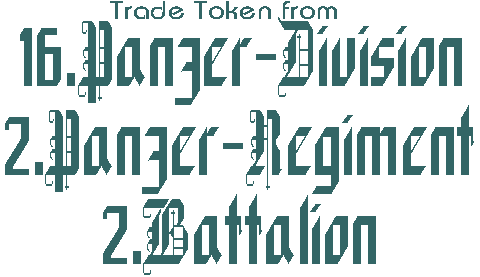
By Jerry Adams , copyright © 1998
The token:
KANTINE / PANZER- / REGT. 2 / II.ABT.25
zinc-round-25mm (beaded border on obverse, and double scalloped border on reverse; estimated date: 1940-44; estimated value: $45)
(Obverse translation: CANTEEN /2ND ARMORED-REGIMENT / 2ND BATTALION)
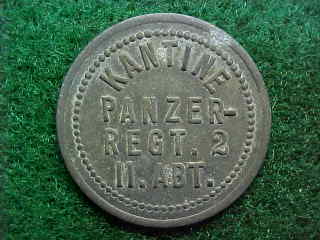
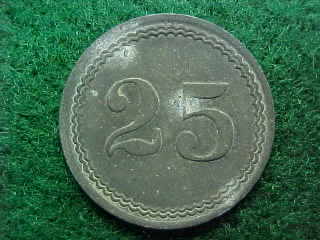
Having always been interested in the military history of World War Two, and collect odd bits of militaria from that war, I was very happy to acquire a zinc token from a German armored unit. I knew that Panzer referred to "tanks" or armored vehicles, and assumed that this token was had something to do with the "canteen" of a German armored unit. The canteen is a military store where soldiers can buy refreshments and provisions, and is typically much smaller than the PX (Post Exchange). In many countries, the soldiers ran the canteens themselves. A military canteen is generally located "on post," near the barracks of the soldiers. Items sold at canteens would include snacks, shaving needs, combs, soap, magazines and small books, drinks including beer and soft drinks, writing paper, envelopes, stamps pens, and other comfort items.
A quick look at the UNIT STRUCTURE of the German Army during World War Two:
| German Military Organizational Term | English translation |
| Armeegruppe | Army Group (100,000 to 300,000 men) |
| Armee | Army (60,000 to 100,000 men) |
| Korps | Corp (40,000 to 60,000 men) |
| Division | Division (between 10,000 & 20,000 men) |
| Brigade | Brigade (5,000 to 7,000 men) |
| Regiment | Regiment (between 2000 & 6000 men) |
| Abteilung | Battalion (between 500 & 1000 men) |
| Kompanie | Company (100 to 200 men) |
| Zug | Platoon (30 to 40 men) |
| Trupp | Squad ( 5 to 10 men) |
There were panzer regiments numbered up into the 500’s in the German Heer (army) during World War Two. The 2.Panzer Regiment was one of the first panzer regiments formed, and carried with it a high degree of respect within the German Army.
1.PANZER DIVISION (1935-1940)
The 2.Panzer-Regiment was formed 1 Oct. 1935 with two battalions (Abteilung) which were composed of four companies. The regiment was assigned to the 1.Panzer Division Mobilized. The Division took part in the invasion of Poland in September 1939, and in May of 1940 took part in the campaign against France, driving through the Ardennes region, cutting off the Allies in Belgium and the Netherlands.
16.PANZER DIVISION (October 1940-1945)
The 16.Panzer Division was formed in August 1940. In October 1940, Panzer Regiment 2 was transferred to the 16.Panzer Division to serve as the nucleus armored Regiment of the Division. After it’s training, the unit was sent to Romania for use in training the Romanian armed forces. The 16.Panzer Division took part in the invasion of the Soviet Union in June of 1941on the southern sector of the front. Their advance took them to the following Soviet cities: Lvov, Pervomaysk, Zaporozhye, Taganrog, Makeyevka, Artemousk and Stalingrad. By Novemeber 18, 1942, the German Army was on the outskirts of Stalingrad, USSR. The Germans had pushed the 62nd Soviet Army back slowly but surely, and resistance increased as they approached the Volga River. At Stalingrad, the 16.Panzer was on the northern end of the German line, near the small town of Rynol, where the 60.Motorized Division joined them in attacks against the railways leading into the steel and tractor (tank)factories on the west banks of the Volga River. The entire 16.Panzer Division was destroyed in the battle for Stalingrad in February 1943.
Panzer crews wearing 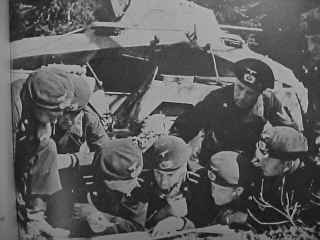 the schutzmutze
the schutzmutze
The 16.Panzer-Division was reformed in March of 1943 in France, then sent to Italy. The 2.Panzer Regiment converted to Panther tanks in late August of 1943. The 16.Panzer was actively engaged in the battles at Salerno and then Naples, Italy where they fought against American forces.
Panzers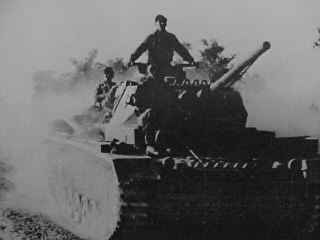 in Russia
in Russia
NOVEMBER-DECEMBER 1943
In the months of November and December 1943, the 16.Panzer was transferred to the eastern front. They arrived about mid December at Bobruysk, USSR and after defensive fighting took part in counter-attacks for the city of Kiev. The 16.Panzer took heavy losses and had to withdraw to the Baranow area on the Vistula River.
SUMMER OF 1944
In the summer of 1944 the 16.Panzer was withdrawn back into Poland, where it was refitted for battle. It was then transferred back to the Baranow region in January 1945. The unit took active part in defensive operations there until pushed back into the area of Brno, Czechoslovakia in March and April of 1945. Portions of the 16.Panzer surrendered to the Soviets and portions surrendered to the Americans.
SERVICE OF THE 2.PANZER-REGIMENT II.BATTALLION
1.Panzer-Division formed (1935)-Oct. 1940: |
1.Panzer-Brigade |
2.Panzer-Regiment |
Panzer-Abteilung II |
16.Panzer-Division formed (1940) – April 1945 |
2.Panzer-Regiment |
Panzer-Abteilung II |
The denomination of 25 Pfenning on this token is a moderately high value for a token. The reason for use of a token at the canteen is unknown. Zinc was used as a coining material for small denomination coins in Nazi Germany starting in 1940, and continued until 1945. My guess is that this token was used in late 1940 and 1941.
All tokens connected to World War Two German military services are rare. Naval tokens seem to be the most common, with ground forces tokens being somewhat harder to find.
Additional German Military tokens of the World War Two era: top left, is a token of Infantry Regiment 41from their Canteen, bottom left is another zinc token of the Canteen of the Infantry Regiment 107, and bottom right is another zinc token from the Canteen at a World War Two German military air base at Neubiberg.
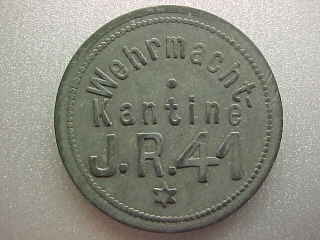
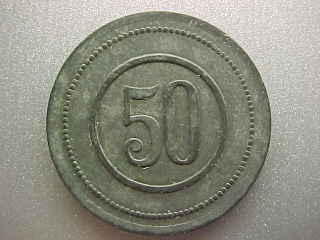
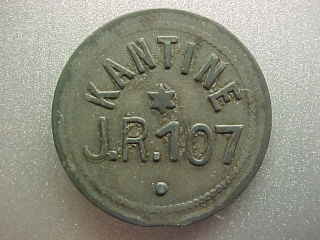
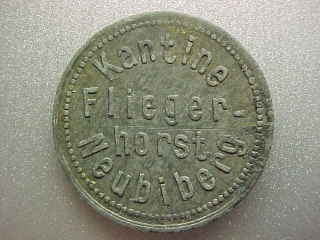
References: Thanks to Jason Pipes for providing much of the information above.
On to page 32 of our token web pages....
updated 29 april 2001